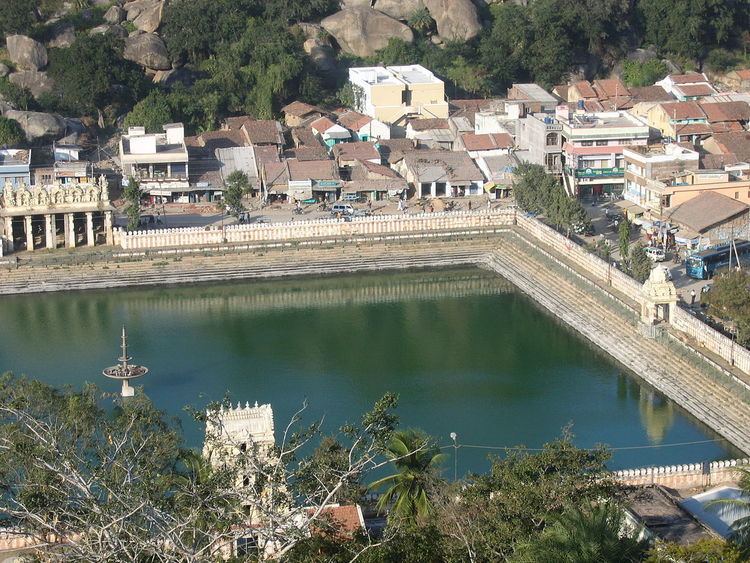 | ||
A Bhaṭṭāraka (Magadhi Prakrit: भट्टारक "holy one") heads traditional Digambara Jain institutions. He is responsible for training scholars, maintenance of libraries, managing endowments, presiding over installation ceremonies and running Jain institutions.
Contents
Overview
The term bhaṭṭāraka was used for Virasena, Bhadrabahu and other notables. It was in the past used for leaders of religious orders in Shaivism, Buddhism and other groups, but currently it is applied to heads of Digambara Jain institutions. Unlike a Digambara monk, a bhaṭṭāraka wears an orange robe, stays in a single place and is involved in management of assets of the institution.
The role of a bhaṭṭāraka is described by Brahm Gyansagar, a disciple of Bhaṭṭāraka Shribhushana of Kashtha Sangh Nanditat Gaccha in seventeenth century of the Vikram era:
Hindi: भट्टारक सोहि जाण भ्रष्टाचर निवारे, धर्म प्रकाशे दोइ भविक जीव बहु तारे
सकल शस्त्र संपूर्ण सूरिमंत्र आराधे, करे गच्छ उद्धार स्वात्मकार्य बहु साधे
Many of the bhattarakas were prolific authors. They wrote hundreds of original books and commentaries on various subjects, in Sanskrit and in local languages. All existing Jain manuscripts available today owe their preservation to the libraries maintained by Bhattarakas. They trained and supported pandits. Until modern times, all pratishthas were supervised by them or pandits (such as Raighu)designated by them.
Present Bhattaraka Seats
Once bhaṭṭārakas were common all over India, but currently, they are present only in South India, with the exception of a new Bhattaraka seat at Hastinapur. Famous bhaṭṭāraka seats include:
Karnataka
Maharashtra
Tamil Nadu
Historical Bhattaraka Seats
Bhaṭṭāraka seats existed at the following places until recent centuries:
- North India: Delhi, Hisar, Haryana, Mathura
- Rajasthan: Jaipur, Nagaur, Ajmer, Chittorgarh, Pratapgarh, Rajasthan, Dungarpur, Narsimhapur, Rishabhdeo, Mahavirji
- Madhya Pradesh: Gwalior, Sonagiri, Ater, Chanderi, Sironj, Garhakota, Panagar
- Gujarat: Idar, Sagwada, Surat, Bhanpur, Sojitra, Kalol, Jerhat
- Maharashtra: Karanja, Nagpur, latur, Nanded, Kolhapur, Nandani
- Karnataka: Malakhed, Karkal, Swadi
The Terapanth movement arose in 17th century because of opposition by elite householders to Bhattarakas. Still many Bhaṭṭāraka seats in North India existed until the beginning of the 20th century. In some locations disputes arose and the reformists opposed existing Bhattarakas because they did not display the scholarship expected, or disapproval of their spending of the institutional funds. Many Bhattarakas were unable to find suitable disciples to take their place after them.
A new Bhattaraka seat has again come into existence at Hastinapur presided by Bhattaraka Ravindra Kirti.
Theories of Origin
There are several theories of how the modern Bhattarka institution originated.
In its modern form, with the Bhattaraka as an orange-robed advanced layman, its founding is often attributed to Prabhachandra of Mula Sangh, Balatkara Gana Saraswati gachchha, who travelled from Pattana (Gujarat) to Delhi, where he was anointed in a ceremony as the first Bhattaraka of Delhi. He was invited by the ruler of Delhi, who is identified as Muhammad Bin Tughlaq.
However Shrutasagara, in his commentary on Shatprabhrita, mentioned Prabhachandra's predecessor Vasantakirti has having adopted body coverage first. The lineage linking Vasabtakirti and Prabhachandra is given as following (see Balatkara Gana):
- Vasantakirti at Mandapadurg
- Vishalakirti (or Prakhyatkirti), Ajmer
- Shubhakirti, Ajmer
- Dharmachandra, Ajmer
- Ratnakirti, Ajmer
- Prabhachandra, who visited Delhi
Originally the wearing of clothes was regarded to be an exception to be used when going out. Until recent time, many Bhattarakas used to discard clothing within the monastery on specific occasions like eating, image consecretion or initiating another Bhattaraka.
